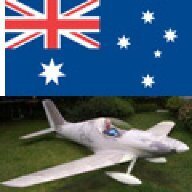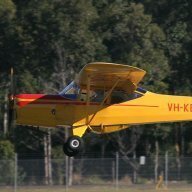-
Posts
1,403 -
Joined
-
Last visited
-
Days Won
9
Content Type
Profiles
Forums
Gallery
Downloads
Blogs
Events
Store
Aircraft
Resources
Tutorials
Articles
Classifieds
Movies
Books
Community Map
Quizzes
Status Updates posted by pylon500
-
G'Day Dave, just wondering if you got any photo's of me in the J-3? If you did, could you send me one? I can take any size (ADSL2+), but if you want to play photoshop, scale to 750dpi across, and save for web down to around 200kb. :) My direct e-mail is <[email protected]>
-
G'Day Dave, just wondering if you got any photo's of me in the J-3? If you did, could you send me one? I can take any size (ADSL2+), but if you want to play photoshop, scale to 750dpi across, and save for web down to around 200kb. :) My direct e-mail is <[email protected]>
-
Yeah, the scale thing is an interesting compromise. All the WAR planes are too small to be practical,as well as having nasty flying habits! If built carefully, a large plane can actually be lighter than a small one. A good example of this would be the Titan T-51. Considering that it is a two seater with retracts, it still does well with only a 912. Maybe a better example could be the Leohle 5151, about the same size as the T-51, but half the weight, only single seat and only needs a 503. Not very pretty or great scale,but these are sometimes the compromise? 95:10 will never change but could be the limit of choices without going into GA experimental and the associated cost. I'm not sure where you're coming from, so cost may not be a problem? Retracts, once again 95:10 has NO rules for or against, only the weight limit. As for other RAA classes, again no rules either way.. Technam-RG, Sabre-RG, Leohle-5151, etc. Might as well keep posting here, I can find it now..... Have you ever been to; this Homebuilt site? You could get some ideas from these guys as well. As for the SR-71, did you also have a close look at; My Harvard? This is another PhotoShop job, believe me real Harvards are BIGGER! I've actually got half of that machine designed in my computer. Harvard plan. Was looking for a war bird and knew people would then ask for a two seat version so thought, 'Why not build a scale two seater in the first place!' Was designed to use a 912s, then discovered the Rotecs', but not sure if I'd use one now? Arthur.
-
Yeah, the scale thing is an interesting compromise. All the WAR planes are too small to be practical,as well as having nasty flying habits! If built carefully, a large plane can actually be lighter than a small one. A good example of this would be the Titan T-51. Considering that it is a two seater with retracts, it still does well with only a 912. Maybe a better example could be the Leohle 5151, about the same size as the T-51, but half the weight, only single seat and only needs a 503. Not very pretty or great scale,but these are sometimes the compromise? 95:10 will never change but could be the limit of choices without going into GA experimental and the associated cost. I'm not sure where you're coming from, so cost may not be a problem? Retracts, once again 95:10 has NO rules for or against, only the weight limit. As for other RAA classes, again no rules either way.. Technam-RG, Sabre-RG, Leohle-5151, etc. Might as well keep posting here, I can find it now..... Have you ever been to; this Homebuilt site? You could get some ideas from these guys as well. As for the SR-71, did you also have a close look at; My Harvard? This is another PhotoShop job, believe me real Harvards are BIGGER! I've actually got half of that machine designed in my computer. Harvard plan. Was looking for a war bird and knew people would then ask for a two seat version so thought, 'Why not build a scale two seater in the first place!' Was designed to use a 912s, then discovered the Rotecs', but not sure if I'd use one now? Arthur.
-
I'm not sure why, but your pm ended up in a different section under 'profile visitor'? But got it now. Yes, the differential drive takes a bit of head scratching, it's a bit like explaining a helicopter swash plate! For the weight you're looking at, belt reduction is probably best. I say reduction because I'm sure you're going to have to use a smaller pair of engines than VW's to stay in the 95:10 weight area, thus they will be by definition higher revving than what we want for our prop(s) I think the 95:10 'two engine' problem is a combination of 'grandfather' clause (Lazair) and the fact I'm fairly sure that no restrictions are actually written in the rules, I guess no one expected it? Extra cooling fans and Oil baths?!! This is one of those projects you have to approach sideways or it can get heavy real fast. Try as I might, I can't think of a better route than two small water cooled two strokes (best power to weight) or maybe a couple of small rotaries?!?! Scary picture at; Turbo-Rotary Aero Light! As for bearings, if there is any length involved with the shafts, you may need to look at some form of flexible coupling, then you need to fit a thrust bearing as well as the usual radial bearings to hold the prop shaft at the front. As for the SR-71, it's a bit of PhotoShop!!, although I still feel the idea is valid. I guess you looked here? Arthur.
-
I'm not sure why, but your pm ended up in a different section under 'profile visitor'? But got it now. Yes, the differential drive takes a bit of head scratching, it's a bit like explaining a helicopter swash plate! For the weight you're looking at, belt reduction is probably best. I say reduction because I'm sure you're going to have to use a smaller pair of engines than VW's to stay in the 95:10 weight area, thus they will be by definition higher revving than what we want for our prop(s) I think the 95:10 'two engine' problem is a combination of 'grandfather' clause (Lazair) and the fact I'm fairly sure that no restrictions are actually written in the rules, I guess no one expected it? Extra cooling fans and Oil baths?!! This is one of those projects you have to approach sideways or it can get heavy real fast. Try as I might, I can't think of a better route than two small water cooled two strokes (best power to weight) or maybe a couple of small rotaries?!?! Scary picture at; Turbo-Rotary Aero Light! As for bearings, if there is any length involved with the shafts, you may need to look at some form of flexible coupling, then you need to fit a thrust bearing as well as the usual radial bearings to hold the prop shaft at the front. As for the SR-71, it's a bit of PhotoShop!!, although I still feel the idea is valid. I guess you looked here? Arthur.
-
G'Day Doug, The Wyvern's not a bad looking plane (thought I had this conversation some time ago?). As for dual engine, there's a few possibilities... You can drive two props from one engine, using something like a differential to split the directions. This is done with some of those small contra-rotating mini helicopters. The trick is to mount one axle fixed to the airframe, drive the housing around with one prop attached to it and the other prop attached to the other end axle. As for two engines, the side by side, reversed direction idea has been used before and worked. I should note though that the two engines were independent of one another, much easier. A couple of Venezuelans' did this with a Cozy, having two Suzuki Swift engines side by side and cantered like a V-8 to allow the drive shaft to run between them. I have a picture, but don't know how to attach to a 'mail' An article appears in EAA Sport Aircraft, May 1998. I would imagine that using two VW's would be a bit more complicated, trying to get the manifolds and exhausts to integrate, not to mention the cooling? I also feel we need to do more to still appear as ultralights, so having two VW's in a plane (even a two seater) is starting to push the envelope, how about a couple of 750/1000 four cyl bike engines? Oddly enough, using water cooled engines would be more practical than aircooled just for the ease of cooling remotely without having to have a really complicated ducting system. Trying to run a common inlet manifold system would be tricky, but not impossible, with the exhaust facing away from each other, they would stay separated on each side to go out through the scale exhaust. If you could build it down to 95:10 weights (two 337's?) it would be totally legal! Arthur.
-
G'Day Doug, The Wyvern's not a bad looking plane (thought I had this conversation some time ago?). As for dual engine, there's a few possibilities... You can drive two props from one engine, using something like a differential to split the directions. This is done with some of those small contra-rotating mini helicopters. The trick is to mount one axle fixed to the airframe, drive the housing around with one prop attached to it and the other prop attached to the other end axle. As for two engines, the side by side, reversed direction idea has been used before and worked. I should note though that the two engines were independent of one another, much easier. A couple of Venezuelans' did this with a Cozy, having two Suzuki Swift engines side by side and cantered like a V-8 to allow the drive shaft to run between them. I have a picture, but don't know how to attach to a 'mail' An article appears in EAA Sport Aircraft, May 1998. I would imagine that using two VW's would be a bit more complicated, trying to get the manifolds and exhausts to integrate, not to mention the cooling? I also feel we need to do more to still appear as ultralights, so having two VW's in a plane (even a two seater) is starting to push the envelope, how about a couple of 750/1000 four cyl bike engines? Oddly enough, using water cooled engines would be more practical than aircooled just for the ease of cooling remotely without having to have a really complicated ducting system. Trying to run a common inlet manifold system would be tricky, but not impossible, with the exhaust facing away from each other, they would stay separated on each side to go out through the scale exhaust. If you could build it down to 95:10 weights (two 337's?) it would be totally legal! Arthur.



